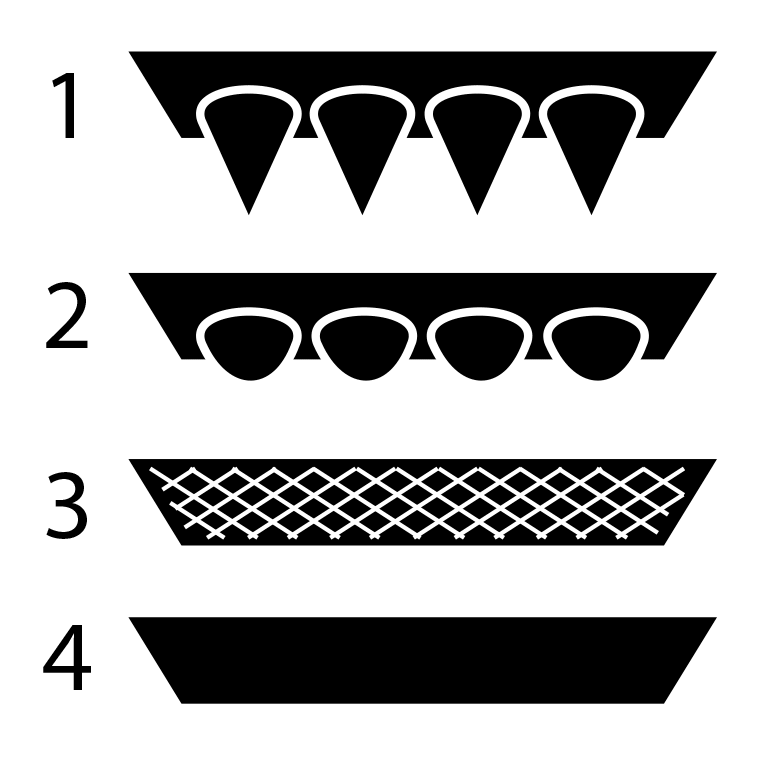
How much is my Hemingray insulator worth? A simple enough question! However, there are many factors to consider when finding the value of your insulator:
- Design Number - The insulator collecting hobby assigns design numbers to each unique insulator design. The most widely-used identification numbering system is the CD (Consolidated Design) number. If you don't know what your insulator's CD number is, you can find it by identifying your insulator.
- Primary Embossing - This is the main embossing on the insulator (such as Hemingray, H.G.CO., Kimble, etc.). Chances are if you're viewing this page, your insulator's primary embossing is Hemingray, H.G.CO., or Patent Dec. 19, 1871! However, Hemingray also made insulators with other names as well. View all primary embossings attributed to Hemingray.
 Base Type - The base is the portion around the bottom outer circle (skirt) of the insulator. Hemingray made 4 different types of bases: 1. Sharp Drip Points (abbreviated SDP), 2. Round Drip Points (RDP), 3. Corrugated Base (CB), and 4. Smooth Base (SB).
Base Type - The base is the portion around the bottom outer circle (skirt) of the insulator. Hemingray made 4 different types of bases: 1. Sharp Drip Points (abbreviated SDP), 2. Round Drip Points (RDP), 3. Corrugated Base (CB), and 4. Smooth Base (SB).- Embossing - Once you have identified the Primary Embossing and Base Type, the next factor that can affect value is the embossing on the insulator. Embossing is typically located on the front (F-Skirt) and rear (R-Skirt) of the insulator, but can also appear on the dome, crown, umbrella, or other area. Each unique embossing for a particular insulator design is assigned an EIN (Embossing Index Number), typically denoted in brackets, e.g. [010].
- Color - The color of the insulator typically makes the most difference in value. For example, an aqua colored insulator might be worth $5, but a cobalt blue insulator might be worth $300! If you aren't sure what color your insulator is, visit the Hemingray Color Guide for a basic guide. The insulator price guide has a much more thorough color guide. Another important thing to note is colors can be altered and there are fakes out there! Visit the Fakes & Reproductions page for more information.
- Condition - The condition of the insulator can also greatly affect value. Naturally the more damage an insulator has, the lower its value. Insulator price guides generally give a range of values (e.g. $20-30). The high end value is usually Mint (no damage), and the low end value would be Near Mint (some damage). More extensive damage would be valued even lower.
- Manufacturing Anomalies - There are many collecting specialists that look for specific attributes of an insulator when it was manufactured: underpoured or overpoured glass, an extra low-set pinhole causing extra glass in the dome (referred to as "dome glass" by collectors), amber or milky swirling in the glass, foreign objects embedded in the glass, etc. Anything unusual can often affect the insulator's value as well.
Once you have the above information, now you can find the value of your insulator. The most recent price guide currently available is the 2023 Insulator Price Guide published by Don Briel. It is available in print and digital form.
Many, but not all, popular styles on this web site also have a value range listed, based on historical and publicly available collecting data. However, most ranges vary widely based on the above factors, so having a good, current insulator price guide is crucial.
TIP: Have you already checked the list of
common Hemingray styles? If your insulator is listed on that page, your insulator's value is likely between $1-$3.
You can also check eBay for insulators like yours:



 Base Type - The base is the portion around the bottom outer circle (skirt) of the insulator. Hemingray made 4 different types of bases: 1. Sharp Drip Points (abbreviated SDP), 2. Round Drip Points (RDP), 3. Corrugated Base (CB), and 4. Smooth Base (SB).
Base Type - The base is the portion around the bottom outer circle (skirt) of the insulator. Hemingray made 4 different types of bases: 1. Sharp Drip Points (abbreviated SDP), 2. Round Drip Points (RDP), 3. Corrugated Base (CB), and 4. Smooth Base (SB).